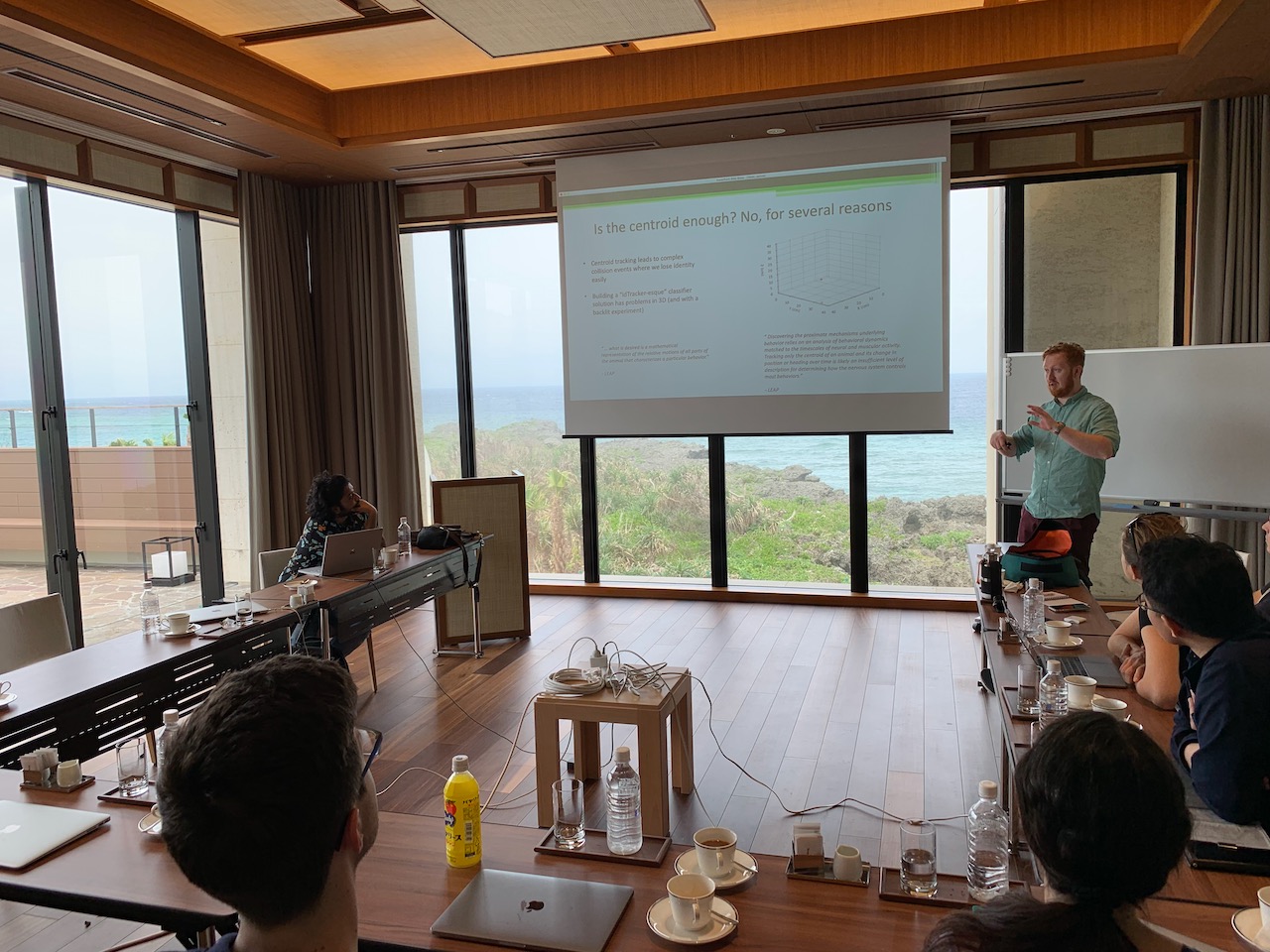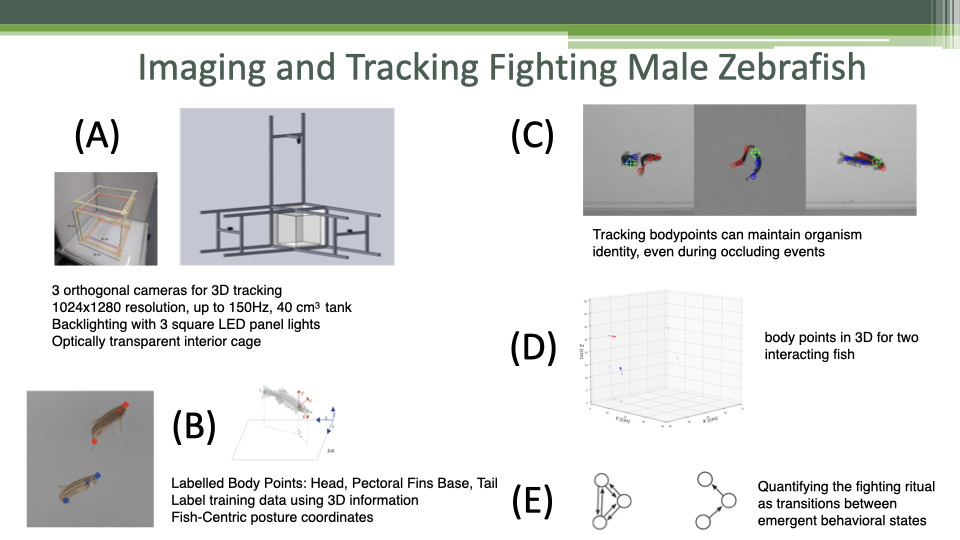FY2019 Annual Report
Biological Physics Theory Unit
Professor Greg J Stephens

Abstract
The Stephens Group is pioneering a new field – the physics of behavior: from individual organisms to entire societies. The science of the living world is overwhelmingly focused on the microscopic: the structure of DNA, the machinery of cells that can convert energy and transports materials, or the pattern of electrical activity in our brains from which thoughts arise. Yet, all of these processes serve the greater evolutionary goals of the organism: to find food, avoid predators and reproduce. This is the behavioral scale, and despite it’s importance, our quantitative understanding of behavior is much less advanced. But how do we quantify the emergent dynamics of entire organisms? What principles characterize living movement? Research in our group addresses these fundamental questions with a modern biophysics approach and model systems ranging from the nematode C. elegans to zebrafish and honeybee collectives. We combine theoretical ideas from statistical physics, information theory and dynamical systems and work in close collaboration with scientists from OIST and around the world to develop and analyze novel, quantitative experiments of organisms in natural motion.
1. Staff
- Prof. Greg J. Stephens
- Ms. Naoko Ogura-Gayler, Research Administrator
- Dr. Kasia Bozek, Group Leader
- Ms. Laetitia Hebert, Software Engineer
- Mr. Tatsuo Izawa, Technicican
- Mr. Yoann Portugal, Technician
- Mr. Tosif Ahamed, PhD Student (degree granted, May 2019)
- Mr. Liam O'Shaughnessy, Visiting Research Student
- Mr. Antonio Carlos Costa, Visiting Research Student
- Mr. Simon Goorney, Research Intern
2. Collaborations
2.1 HFSP Program Grant
- The physics of social behavior in the 3-dimensional shoaling of zebrafish
- Type of collaboration: Joint research
- Researchers:
- Professor Ichiro Masai, OIST Graduate University
- Professor Joshua Shaevitz, Princeton University
2.2 Physics of Social Insect Behavior
- Type of collaboration: Joint research
- Researchers:
- Professor Orit Peleg, University of Colorado
- Professor Kasia Bozek, University of Cologne
2.3 Dynamical Appoaches to Complex Systems
- Type of collaboration: Joint research
- Researchers:
- Dr. David Jordon, Cambridge University
2.4 Physics of Squid Behavior
- Type of collaboration: Joint research
- Researchers:
- Prof Sam Reiter, OIST Graduate University
3. Activities and Findings
3.1 Research Highlights
In FY2019 the Biological Physics Theory Unit finalized a first-generation high-resolution imaging apparatus and 3D tracking solution for multiple bodypoints of multiple, interacting zebrafish (Fig 1) and released our first comprehensive preprint on honey bee detection, tracking and colony-wide behavioral analysis (Fig 2). Our zebrafish work was presented publicaly for the first time in international meetings in the UK, Netherlands and in the US. We were also pleased to have theoretical work on optimal sensing published in Nature Communications (Figure 3). The optimal sensing research was led by Dr. Vudiwat (Wave) Ngampruetikorn, a former postdoc in the unit.

Figure 1: With a mature experimental design (A) we leverage advances in machine vison to label mulitple body points on mutliple fish (B), keep track of fish identity (C) to reconstruct body point trajectories in 3D (D). We now focus our approach on understanding the dynamics of dyadic dominance fighting in male fish (E).

Figure 2: We use a segmentation network (A) to infer bee and brood positions (yellow and red marks), bee posture type – bee inside of a comb cell (yellow round symbols, denoted later as cell-bees) and fully visible bee (yellow arrows) – and the orientation angle of fully visible bees, allowing for detailed sociometric analysis over long timespans and across multiple colonies (right). (B) Embeddings of visual bee features link detections across frames into trajectories (Bozek et al, submitted 2020)

Figure 3: Energy Consumption and Cooperation for Optimal Sensing. We introduce a minimal model of a sensory complex which includes both external signals and interactions between the sensors (Left) (a) Physical examples of a sensor system with two interacting sensors: a pair of chemoreceptors with receptor coupling (left) and a pair of transcriptional regulations of gene expressions with cross-feedback (right). (b) Model schematic. Each sensor is endowed with binary states. (c) The field \(h_i\) favours the states with \(s_i=+1\) (top row); the coupling J favours the correlated states (--) and (++) (bottom left) and the nonequilibrium drive t generates a cyclic bias (bottom right). (Right) Optimal sensing in the high-signal-correlation limit. For perfectly correlated Gaussian signals, the nonequilibrium information gain is largest in the noiseless limit. (a) The nonequilibrium gain as a function of sensor reliability \(\beta\). The gain grows from zero at \(\beta\)=1 suggesting that the enhancement results from the ability to distinguish additional signal features. (b) Optimal sensing strategy for varying noise levels. (Ngampruetikorn et al, Nat Comm 2020)
3.2 Professional Activiites
- GJ Stephens, Co-director (with T Mora, I Nemenman & A Walczak), Boulder School for Condensed Matter and Material Physics: Theoretical Biophysics, Boulder, USA Jul 8-26 (2019)
- GJ Stephens, Co-organizer (with O Peleg), Physics of Social Behavior Focus Session, APS March Meeting, Denver USA Mar 2-6 (2020)
3.3 PhD Dissertations
Tosif Ahamed (Supervisor: GJ Stephens Co-supervisor: Ichiro Maruyama)
Thesis Title: Capturing the Nonlinear Dynamics of Animal Behavior
OIST Graduate University http://doi.org/10.15102/1394.00000823
4. Publications
4.1 Journals and Preprints
-
K Bozek, L Hebert Y Portugal & GJ Stephens, Markerless tracking of an entire insect colony (2020); bioRxiv:2020.03.26.007302.
-
T Ahamed, A Carlos Costa & GJ Stephens, Capturing the continuous complexity of behavior in C. elegans, (2019);bioRxiv 827535.
-
V Ngampruetikorn, DJ Schwab & GJ Stephens, Energy consumption and cooperation for optimal sensing, Nat Comm, 11 (975) (2020); arXiv:1809.04095 [physics.bio-ph].
-
R Kok, L Hebert, G Huelsz-Prince, YJ Goos, X Zheng, K Bozek, GJ Stephens, S. Tans & JS van Zon, OrganoidTracker: efficient cell tracking using machine learning and manual error correction (2020);bioRxiv 2020.03.18.996421.
4.2 Books and other one-time publications
Nothing to report
4.3 Oral and Poster Presentations
-
K Bozek, LifeTime opening conference, Berlin DE (May 2019)
-
K Bozek, University of Cologne, Cologne DE (May 2019)
-
K Bozek, Berlin Institute for Medical Systems Biology, Berlin DE (May 2019)
-
K Bozek, Institute for Computational Biology, Helmholtz Center, Munich DE (May 2019)
-
GJ Stephens, Center for Integrative Biology, Toulouse FR (Jun 2019)
-
K Bozek, Nordrhein Westphalia return program symposium, Düsseldorf, DE (Jul 2019)
-
K Bozek, Max-Planck Lise Meitner Symposium, Berlin, DE (Jul 2019)
-
GJ Stephens, OIST Computational Neuroscience Course, Okinawa Japan (Jul 2019)
-
GJ Stephens, Workshop on Locomotion and Navigation: From Flies to Robots, ICTP, Trieste IT (Jul 2019)
-
GJ Stephens, Max Planck Institute for Brain Research, Frankfurt DE (Sep 2019)
-
L O'Shaugnessy*, T Izawa, JW Shaevitz & GJ Stephens, Physics of Living Matter Symposium, Cambridge UK (Sep 2019)
-
T Ahamed*, AC Costa, GJ Stephens, Ignite Session 2, Conference on Complex Systems, Singapore (Oct 2019)
-
L O'Shaugnessy*, T Izawa, JW Shaevitz & GJ Stephens, DutchBiophysics, Veldhoven NL (Oct 2019)
-
GJ Stephens, IMPRS Grand Challenges Symposium, Max Planck Institute for Ornithology, Seewiesen DE (Oct 2019)
-
GJ Stephens, Dynamics Seminar, Exeter University, Exeter UK (Nov 2019)
-
GJ Stephens, Physics of Living Systems Seminar, Georgia Institute of Technology, Atlanta US (Jan 2020)
-
L O'Shaugnessy*, T Izawa, JW Shaevitz & GJ Stephens, APS March Meeting, Denver US (Mar 2020)
-
AC Costa*, T Ahamed, D Jordan, GJ Stephens, APS March Meeting, Denver US (Mar 2020)
5. Intellectual Property Rights and Other Specific Achievements
Nothing to report
6. Meetings and Events
6.1 Phenotype to Function: Predicting compound mode of action from behavioural fingerprints
- Date: March 27, 2018
- Venue: OIST Campus Lab 1
- Speaker: Dr. Andre Brown, Group leader at the MRC London Institute of Medical Sciences at Imperial College London
Travels, Meeting
- Boulder School in Condensed Matter and Materials Physics 2019: Theoretical Biophysics, Boulder US (Jul 2019)
- Conference on Complex Systems, Singapore (Oct 2019)
- Visit to the group of Prof. Mei Zhen, University of Toronto, Toronto CA (Dec 2019)
- American Physical Society March Meeting, Denver US (Mar 20200)
- Visit to the group of Prof. Orit Peleg, University of Colorado, Boulder US (Mar 2020)
7. Other
Nothing to report.



